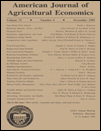Producer Welfare Consequences of Regulating Chemical Residues on Agricultural Crops: Maleic Hydrazide and Tobacco
Abstract
A procedure is presented to calculate welfare consequences of chemical regulation from demand curves when input applications are unobserved, and is applied to maleic hydrazide and tobacco. The relationship between chemical residues and weather variables and prices is estimated, and from this we derive demand curves using an application-residue relationship estimated using research station data. Chemical price levels required to attain given regulatory goals are estimated. Yearly producer losses from a chemical ban range from $@@-@@6 million to $@@-@@14 million, two to five times greater than from a tax achieving a 95% assurance rate of residues falling below a proposed standard.




